What'sNEW Archives, July-September 2005
 30 September 2005 30 September 2005
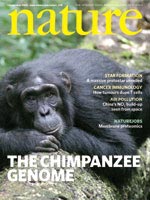 The chimp genome has been sequenced. What it may reveal about evolution since the chimp-human split interests everyone, incuding us. We recognize that studying evolution by comparing today's genomes requires inference, and the method leaves many questions unanswered. Nonetheless, some basic findings seem sure (and we are warming up to the method):
The chimp genome has been sequenced. What it may reveal about evolution since the chimp-human split interests everyone, incuding us. We recognize that studying evolution by comparing today's genomes requires inference, and the method leaves many questions unanswered. Nonetheless, some basic findings seem sure (and we are warming up to the method):
- Orthologous genes between the humans and chimps are very similar; 29% encode proteins that are identical.
- Aligned sequences differ by single nucleotide substitutions at a rate of 1.23%. Some of these must reflect within-species polymorphisms, but the majority, an estimated 1.06%, represent fixed divergences between the species.
- The median number of non-synonymous and synonymous nucleotide substitutions per gene are two and three, respectively.
- Positive selection is most noticeable in genes related to immunity and host defense, reproduction and olefaction.
- Another study shows relaxed constraint in hominids' gene promoter regions versus those of murids.
- Purifying selection appears to primarily affect genes pertaining to intracellular signalling, metabolism, neurogenesis and synaptic transmission, but even some silent sequences seem especially well-conserved.
- Insertions or deletions of polynucleotide sequences (indels) are rarer than single-nucleotide substitutions, but by their wholesale nature, they account for more of the total dfference between the human and chimp genomes, 1.5%.
- Certain transposable elements have been more active in humans.
- Chimps have acquired two new families of retroviral elements since the two species diverged.
- Processed pseudogenes appear to have arisen at a rate of ~50 per million years since the species diverged.
- Two chromosomes in chimps are fused into one in humans.
- At least seventeen human genes contain exons missing in chimps.
Brief comments: Two non-synonymous nucleotide substitutions per gene are clearly too few to have composed any new genes in the standard, gradual darwinian manner. Insertions and deletions per gene are even rarer, and could explore only the tiniest fraction of genome sequence space by the random search method. But if the search is not random, the data may be made rational. For nucleotide substitutions, perhaps genome operating systems have the capability to vary only the right few nucleotides necessary for optimizing a gene within its given range. For insertions and deletions of larger blocks of nucleotides, perhaps other subsystems are able to recognize compatible strands and their exact junction points. With randomness thus reduced, evolution could explore only the fruitful parts of genome sequence space. In our philosophy, macroevolutionary advances depend on new genetic programs that must be acquired by gene transfer. The transfer may happen in stages, and generations of natural selection would be needed to sort and deploy acquired sequences. For turning on the new programs, relaxed constraint in their regulatory regions might be important. The seventeen human genes with exons missing in chimps would support our contention that new evolutionary programs are supplied by gene transfer. Beyond them, the current sequence comparison suggests to us that recent human evolution comprised lots of post-transfer genomic activity.
 The Chimpanzee Sequencing and Analysis Consortium, "Initial sequence of the chimpanzee genome and comparison with the human genome" [abstract], doi:10.1038/nature04072, p 69-87 v 437, Nature, 1 Sep 2005. The Chimpanzee Sequencing and Analysis Consortium, "Initial sequence of the chimpanzee genome and comparison with the human genome" [abstract], doi:10.1038/nature04072, p 69-87 v 437, Nature, 1 Sep 2005.
 Wen-Hsiung Li and Matthew A. Saunders, "The Chimpanzee Genome" [text], p 50-51 v 437, Nature, 1 Sep 2005. Wen-Hsiung Li and Matthew A. Saunders, "The Chimpanzee Genome" [text], p 50-51 v 437, Nature, 1 Sep 2005.
 Louie N. van de Lagemaat et al., "Genomic deletions and precise removal of transposable elements mediated by short identical DNA segments in primates" [abstract], doi:10.1101/gr.3910705, p 1243-1249 v 15, Genome Research, Sep 2005. Also see commentary in ScienceDaily, 6 Sep 2005. Louie N. van de Lagemaat et al., "Genomic deletions and precise removal of transposable elements mediated by short identical DNA segments in primates" [abstract], doi:10.1101/gr.3910705, p 1243-1249 v 15, Genome Research, Sep 2005. Also see commentary in ScienceDaily, 6 Sep 2005.
 Rasmus Nielsen et al., "A Scan for Positively Selected Genes in the Genomes of Humans and Chimpanzees" [text], doi:10.1371/journal.pbio.0030170, v 3 n 6, PLoS Biology, June 2005. Rasmus Nielsen et al., "A Scan for Positively Selected Genes in the Genomes of Humans and Chimpanzees" [text], doi:10.1371/journal.pbio.0030170, v 3 n 6, PLoS Biology, June 2005.
 Ze Cheng et al., "A genome-wide comparison of recent chimpanzee and human segmental duplications" [abstract], doi:10.1038/nature04000, p 88-93 v 437, Nature, 1 Sep 2005. Ze Cheng et al., "A genome-wide comparison of recent chimpanzee and human segmental duplications" [abstract], doi:10.1038/nature04000, p 88-93 v 437, Nature, 1 Sep 2005.
 Tera L. Newman et al., "A genome-wide survey of structural variation between human and chimpanzee" [abstract], doi:10.1101/gr.4338005, p 1344-1356 v 15, Genome Research, Oct (online 16 Sep) 2005. Tera L. Newman et al., "A genome-wide survey of structural variation between human and chimpanzee" [abstract], doi:10.1101/gr.4338005, p 1344-1356 v 15, Genome Research, Oct (online 16 Sep) 2005.
 A New View of Human-Chimpanzee Genome Differences, Howard Hughes Medical Institute, 01 Sep 2005. A New View of Human-Chimpanzee Genome Differences, Howard Hughes Medical Institute, 01 Sep 2005.
 Big differences in duplicated DNA distinguish chimp and human genomes, University of Washington News, 31 Aug 2005. Big differences in duplicated DNA distinguish chimp and human genomes, University of Washington News, 31 Aug 2005.
 Cornell Finds Natural Selection in Humans, Newswise, 24 Oct 2005. Cornell Finds Natural Selection in Humans, Newswise, 24 Oct 2005.
 Neo-Darwinism... is a related CA webpage. Neo-Darwinism... is a related CA webpage.
 Viruses and Other Gene Transfer Mechanisms is a related CA webpage. [Next-What'sNEW about HGT-Prev] Viruses and Other Gene Transfer Mechanisms is a related CA webpage. [Next-What'sNEW about HGT-Prev]
 Macroevolutionary Progress Redefined: Can It Happen Without Gene Transfer? is a related CA webpage. Macroevolutionary Progress Redefined: Can It Happen Without Gene Transfer? is a related CA webpage.
 Human Genome Search... is a related CA webpage. Human Genome Search... is a related CA webpage.
 New genetic programs in Darwinism and strong panspermia is a related CA webpage. New genetic programs in Darwinism and strong panspermia is a related CA webpage.
 Duplication Makes a New Primate Gene is a related CA webpage. Duplication Makes a New Primate Gene is a related CA webpage.
 Thanks, Jim Galasyn. Thanks, Jim Galasyn.
 26 September 2005 26 September 2005
Common bacteria share an infinite gene pool?! When a distinguished, international research team compared the genomes of eight strains of a common pathogen, this was their conclusion. The genomes contained between 2,000 and 2,500 genes each. Extrapolating from its analysis of them, the team observed that about 1,806 genes would be common to all strains, and they called this group the "core genome." The remaining genes are peculiar to certain strains — they named this group the "pan-genome."
 One of eight sequenced genomes of Streptococcus agalactiae [group B Streptococcus (GBS)]. Boxes show where pan-genes would be found. One of eight sequenced genomes of Streptococcus agalactiae [group B Streptococcus (GBS)]. Boxes show where pan-genes would be found. |
Within the pan-genome, some genes are unique to a single strain. During the study, as the number of compared genomes increased from two to eight, matches turned up for genes that had previously looked unique, and fewer new unique genes were observed. But the extrapolation of this curve did not approach zero; it became flat at 33. "In other words, the model predicts that for every new GBS genome sequenced, an average of 33 new strain-specific genes will be identified and added to the pan-genome." In theory, therefore, the pan-genome of this species would have infinitely many genes! The team admits that additional sequences may improve their understanding. They add —
- Nevertheless, the prediction of an open pan-genome is not surprising if we consider that sequencing a few hundred liters of water from the Sargasso Sea identified 1.2 million unknown genes from 1,800 predicted genomic species.
- If we consider that there are 10^31 bacteriophages on earth..., which infect 10^24 bacteria per second, we can imagine that a continuous flow of genetic material occurs between bacteria sharing the same environments.
- These results suggest that the environmental gene pool available for inclusion by mechanisms such as horizontal transfer, transposition, and transformation is much larger than previously estimated.
- It has been shown that the horizontal transfer of as little as one gene between two GBS serotypes can lead to [an important phenotypic change].
- These findings have implications for... evolution.
 Hervé Tettelin et al., "Genome analysis of multiple pathogenic isolates of Streptococcus agalactiae: Implications for the microbial 'pan-genome'" [link], doi:10.1073/pnas.0506758102, p 13950-13955 v 102, Proc. Natl. Acad. Sci. USA, 27 Sep (online 19 Sep) 2005. "Mathematical extrapolation of the data suggests that the gene reservoir available for inclusion in the S. agalactiae pan-genome is vast and that unique genes will continue to be identified even after sequencing hundreds of genomes." Hervé Tettelin et al., "Genome analysis of multiple pathogenic isolates of Streptococcus agalactiae: Implications for the microbial 'pan-genome'" [link], doi:10.1073/pnas.0506758102, p 13950-13955 v 102, Proc. Natl. Acad. Sci. USA, 27 Sep (online 19 Sep) 2005. "Mathematical extrapolation of the data suggests that the gene reservoir available for inclusion in the S. agalactiae pan-genome is vast and that unique genes will continue to be identified even after sequencing hundreds of genomes."
 Researchers Predict Infinite Genomes, newswise.com, 22 Sep 2005. Researchers Predict Infinite Genomes, newswise.com, 22 Sep 2005.
 Genetics is a related section of CA's Neo-Darwinism... webpage. Genetics is a related section of CA's Neo-Darwinism... webpage.
 Viruses and Other Gene Transfer Mechanisms is a related CA webpage. [Next-What'sNEW about HGT-Prev] Viruses and Other Gene Transfer Mechanisms is a related CA webpage. [Next-What'sNEW about HGT-Prev]
 New genes can be acquired only via HGT: local hub for HGT among prokaryotes since 10 Mar 2021. New genes can be acquired only via HGT: local hub for HGT among prokaryotes since 10 Mar 2021.
 23 September 2005 23 September 2005
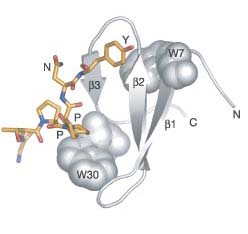 Today's protein families have been fine-tuned from ancient templates. This conclusion emerged unexpectedly from research into the rules that govern protein folding at Southwestern Medical Center in Dallas. Investigators there used statistical coupling analysis (SCA) to analyze a large family of small protein modules called the WW domains. (These domains, 37 amino acids in length, bind to certain proline-rich target sequences.) The research team compared 42 randomly chosen, naturally occurring variants of the WW domain with equally many artificial ones created by each of two algorithms. One of the algorithms substituted residues according to the "mutually evolving network" rules observed in nature; the other one didn't. Only the former algorithm produced sequences that would fold into functional protein modules. While this result interested the researchers, they add, "More surprising is the finding of sparseness." They elaborated —
Today's protein families have been fine-tuned from ancient templates. This conclusion emerged unexpectedly from research into the rules that govern protein folding at Southwestern Medical Center in Dallas. Investigators there used statistical coupling analysis (SCA) to analyze a large family of small protein modules called the WW domains. (These domains, 37 amino acids in length, bind to certain proline-rich target sequences.) The research team compared 42 randomly chosen, naturally occurring variants of the WW domain with equally many artificial ones created by each of two algorithms. One of the algorithms substituted residues according to the "mutually evolving network" rules observed in nature; the other one didn't. Only the former algorithm produced sequences that would fold into functional protein modules. While this result interested the researchers, they add, "More surprising is the finding of sparseness." They elaborated —
- The SCA implies an unexpected degree of simplicity in amino acid interactions, with far fewer important constraints between residue pairs than would be expected.
- The data here suggest that... information specifying binding specificity is captured in positional interactions that are in the deep evolutionary record.
- What we have found is the body of information that is fundamentally ancient within each protein family, and that information is enough to specify the structure of modern-day proteins.
- We are suggesting that the functions proteins have today are the result of fine-tuning a basic ancestral template.
In the theory we promote, darwinian evolution can optimize or fine-tune genetic programs within narrow limits only, but the basic programs are as old as life itself. We think this research supports our view.
 Michael Socolich, Steve W. Lockless et al., "Evolutionary information for specifying a protein fold" [abstract], doi:10.1038/nature03991, p 512-518 v 437, Nature, 22 Sep 2005. Michael Socolich, Steve W. Lockless et al., "Evolutionary information for specifying a protein fold" [abstract], doi:10.1038/nature03991, p 512-518 v 437, Nature, 22 Sep 2005.
 William P. Russ et al., "Natural-like function in artificial WW domains" [abstract], doi:10.1038/nature03990, p 579-583 v 437, Nature, 22 Sep 2005. William P. Russ et al., "Natural-like function in artificial WW domains" [abstract], doi:10.1038/nature03990, p 579-583 v 437, Nature, 22 Sep 2005.
 Jeffery W. Kelly, "Structural biology: Form and function instructions" [text], doi:10.1038/437486a, p 486-487 v 437, Nature, 22 Sep 2005. Jeffery W. Kelly, "Structural biology: Form and function instructions" [text], doi:10.1038/437486a, p 486-487 v 437, Nature, 22 Sep 2005.
 Follow the sequence, Editor's Summary, Nature, 22 Sep 2005. Follow the sequence, Editor's Summary, Nature, 22 Sep 2005.
 Researchers create functioning artificial proteins using nature's rules, The University of Texas Southwestern Medical Center at Dallas, 21 Sep 2005. Researchers create functioning artificial proteins using nature's rules, The University of Texas Southwestern Medical Center at Dallas, 21 Sep 2005.
 Does Microevolution Explain Macroevolution?, a section of our "Neo-Darwinism..." page, discusses darwinian optimizing evolution. Does Microevolution Explain Macroevolution?, a section of our "Neo-Darwinism..." page, discusses darwinian optimizing evolution.
 Viruses and Other Gene Transfer Mechanisms is a related CA webpage. [Next-What'sNEW about HGT-Prev] Viruses and Other Gene Transfer Mechanisms is a related CA webpage. [Next-What'sNEW about HGT-Prev]
 Thanks, Jerry Chancellor. Thanks, Jerry Chancellor.
 22 September 2005 22 September 2005
Prokaryote genomes reveal extensive gene transfer. Three Australian biologists examined all 144 prokaryotic genomes available to them to see if a reliable phylogenetic tree can be drawn. They conclude yes, because many genes are inherited vertically. They also write, "We do find extensive evidence for the preferential transfer of metabolic genes; acquisition of such genes would allow organisms to gain access to new energy and nutrient sources, thereby increasing their ability to colonize or compete in the environment. Our results clearly show that genetic modification of organisms by lateral transfer is a widespread natural phenomenon."
 Robert G. Beiko et al., "Highways of gene sharing in prokaryotes" [abstract], doi: 10.1073/pnas.0504068102, p 14332-14337 v 102, Proc. Natl. Acad. Sci. USA, (online 21 Sep) 4 Oct 2005. Robert G. Beiko et al., "Highways of gene sharing in prokaryotes" [abstract], doi: 10.1073/pnas.0504068102, p 14332-14337 v 102, Proc. Natl. Acad. Sci. USA, (online 21 Sep) 4 Oct 2005.
 Lateral thinking produces first map of gene transmission, EurekAlert!, 10 Nov 2005. Lateral thinking produces first map of gene transmission, EurekAlert!, 10 Nov 2005.
 Viruses and Other Gene Transfer Mechanisms is a related CA webpage. [Next-What'sNEW about HGT-Prev] Viruses and Other Gene Transfer Mechanisms is a related CA webpage. [Next-What'sNEW about HGT-Prev]
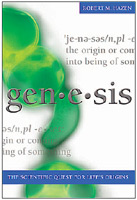
 22 September 2005 22 September 2005
Genesis, a new book about the origin of life is being promoted by the National Academies Press. Author Robert Hazen believes that "emergence" can produce almost anything, and he accepts the RNA World as an established fact. He explains that evidence thereof is missing because, "When modern cells emerged, they quickly consumed virtually all traces of the earlier stages of chemical evolution." And although he is well-acquainted with astrobiology, he never mentions panspermia. Most interesting to us, however, is that a book about the origin of life, by "one of the world's foremost scientists seeking answers to these questions," can deal with hardware (chemistry) only and completely ignore the software aspect of the problem. Has science given up on that issue? On the other hand, Hazen gives a fair survey of the competing mainstream theories and some enjoyable glimpses of the personalities behind them.
 Robert Hazen, Genesis: The Scientific Quest for Life's Origins, ISBN 0-309-65381-9, 368 pages, Joseph Henry Press, 2005. Robert Hazen, Genesis: The Scientific Quest for Life's Origins, ISBN 0-309-65381-9, 368 pages, Joseph Henry Press, 2005.
 Leslie Orgel reviews Genesis..., [Editor's Summary], p 915 v 439, Nature, 23 Feb 2006. Leslie Orgel reviews Genesis..., [Editor's Summary], p 915 v 439, Nature, 23 Feb 2006.
 The RNA World is CA's main webpage about origin-of-life theories. The RNA World is CA's main webpage about origin-of-life theories.
 Ken Jopp replies about the "software" aspect, 22 Sep 2005. Ken Jopp replies about the "software" aspect, 22 Sep 2005.
 9 Nov 2006: Robert Hazen was the featured speaker at Harvard's Origins of Life inaugural symposium, 8 Nov 2006. 9 Nov 2006: Robert Hazen was the featured speaker at Harvard's Origins of Life inaugural symposium, 8 Nov 2006.
 20 September 2005 20 September 2005
New website navigation for HGT — News related to the role of horizontal gene transfer (HGT) in evolution is accumulating rapidly. News we consider the most important is originally reported on the main What'sNEW page and crosslinked with our "Viruses..." webpage. Since 1997, more than 90 news articles about HGT have appeared here. We think the cumulative story they tell is impressive, but, before now, it would have been tedious to view them in sequence. To make that easier we have now linked them together, one-to-the-next. The new links [in brackets] follow our existing link to the "Viruses..." webpage, as below:
 Viruses and Other Gene Transfer Mechanisms contains a text box that explains more about this feature. [Next-What'sNEW about HGT-Prev] Viruses and Other Gene Transfer Mechanisms contains a text box that explains more about this feature. [Next-What'sNEW about HGT-Prev]
 18 September 2005 18 September 2005
Mobile Genetic Elements afford their prokaryotic hosts access to vast genetic resources — Laura S. Frost, Raphael Leplae, Anne O. Summers and Ariane Toussaint
 Laura S. Frost et al., "Mobile Genetic Elements: The Agents of Open Source Evolution" [abstract], doi:10.1038/nrmicro1235, p 722-732 v 3, Nature Reviews Microbiology, Sep 2005. Laura S. Frost et al., "Mobile Genetic Elements: The Agents of Open Source Evolution" [abstract], doi:10.1038/nrmicro1235, p 722-732 v 3, Nature Reviews Microbiology, Sep 2005.
 Viruses and Other Gene Transfer Mechanisms is a related CA webpage. [Next-What'sNEW about HGT-Prev] Viruses and Other Gene Transfer Mechanisms is a related CA webpage. [Next-What'sNEW about HGT-Prev]
 16 September 2005 16 September 2005
The earliest complex animals... appear to have arisen about 500 million years ago, over a period of some 15 million years. Evidence from evo devo shows that all the genes for building those complex animals existed long before that morphological explosion — Lewis Wolpert
 Lewis Wolpert, "Clever Tinkering" (review of Endless Forms Most Beautiful by Sean B. Caroll) [text], p 467-469 v 93, American Scientist, Sep-Oct 2005. Lewis Wolpert, "Clever Tinkering" (review of Endless Forms Most Beautiful by Sean B. Caroll) [text], p 467-469 v 93, American Scientist, Sep-Oct 2005.
 Viruses and Other Gene Transfer Mechanisms is a related CA webpage. [Next-What'sNEW about HGT-Prev] Viruses and Other Gene Transfer Mechanisms is a related CA webpage. [Next-What'sNEW about HGT-Prev]
 Can Computers Mimic Darwinian Evolution? explains how in cosmic ancestry the introduction of new genes "may occur immediately before or long before the time when the genes are first expressed on Earth." Can Computers Mimic Darwinian Evolution? explains how in cosmic ancestry the introduction of new genes "may occur immediately before or long before the time when the genes are first expressed on Earth."
 Metazoan Genes Older Than Metazoa? is a related CA webpage. Metazoan Genes Older Than Metazoa? is a related CA webpage.
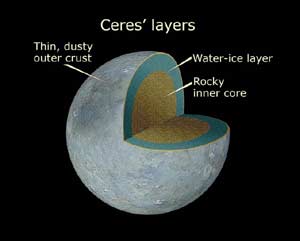
 15 September 2005 15 September 2005
Deep frozen water probably lies just below the crust of Ceres, according to a team of US astronomers who studied its shape and surface features. The shape is consistent with a "relaxed" rotating body and matches a model with "a rocky core and a water-ice mantle." Furthermore, the apparent shallowness of its widest craters is best explained by flooding. The largest known asteroid, Ceres now looks more like a small watery moon or planet. (Ceres is about 487 km in diameter at its equator, and about 2.077 times as dense as water, on average. The Hubble Space Telescope obtained images for this study during nine orbits in December 2003 and January 2004.)
 P. C. Thomas et al., "Differentiation of the asteroid Ceres as revealed by its shape" [abstract], doi:10.1038/nature03938, p 224-226 v 437, Nature, 8 Sep 2005. P. C. Thomas et al., "Differentiation of the asteroid Ceres as revealed by its shape" [abstract], doi:10.1038/nature03938, p 224-226 v 437, Nature, 8 Sep 2005.
 Snowball Ceres?, Astrobiology Magazine, 14 Sep 2005. Snowball Ceres?, Astrobiology Magazine, 14 Sep 2005.
 Life on Europa or Other Moons? is a related CA webpage. Life on Europa or Other Moons? is a related CA webpage.
 Thanks, Jerry Chancellor. Thanks, Jerry Chancellor.
 8 September 2005
8 September 2005
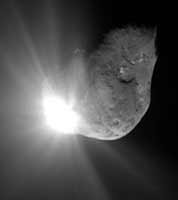 Deep inside comet Tempel 1 there are lots of organic compounds, planetary scientist Michael A'Hearn announced today. A 370-kilogram projectile from NASA's Deep Impact mission collided with the comet and penetrated a layer of fine icy dust at least 30 feet deep on July 4th. While the data are still being analysed, organics in the interior of a comet are confirmed for the first time. Experts are noting that these could have played a major role in the origin of life on Earth. We welcome this small paradigm shift.
Deep inside comet Tempel 1 there are lots of organic compounds, planetary scientist Michael A'Hearn announced today. A 370-kilogram projectile from NASA's Deep Impact mission collided with the comet and penetrated a layer of fine icy dust at least 30 feet deep on July 4th. While the data are still being analysed, organics in the interior of a comet are confirmed for the first time. Experts are noting that these could have played a major role in the origin of life on Earth. We welcome this small paradigm shift.
 M. F. A'Hearn et al., "Deep Impact: Excavating Comet Tempel 1" [abstract], doi:10.1126/science.1118923, p 258-264 v 310, Science, 14 Oct (online 8 Sep) 2005. M. F. A'Hearn et al., "Deep Impact: Excavating Comet Tempel 1" [abstract], doi:10.1126/science.1118923, p 258-264 v 310, Science, 14 Oct (online 8 Sep) 2005.
 K. J. Meech et al., "Deep Impact: Observations from a Worldwide Earth-Based Campaign" [abstract], doi:10.1126/science.1118978, p 265-269
v 310, Science, 14 Oct (online 8 Sep) 2005. K. J. Meech et al., "Deep Impact: Observations from a Worldwide Earth-Based Campaign" [abstract], doi:10.1126/science.1118978, p 265-269
v 310, Science, 14 Oct (online 8 Sep) 2005.
 Horst Uwe Keller et al., "Deep Impact Observations by OSIRIS Onboard the Rosetta Spacecraft" [abstract], doi:10.1126/science.1119020, p 281-283 v 310, Science, 14 Oct (online 8 Sep) 2005. Horst Uwe Keller et al., "Deep Impact Observations by OSIRIS Onboard the Rosetta Spacecraft" [abstract], doi:10.1126/science.1119020, p 281-283 v 310, Science, 14 Oct (online 8 Sep) 2005.
 NASA's Spitzer and Deep Impact Build Recipe for Comet Soup, by Whitney Clavin, Jet Propulsion Laboratory, 7 Sep 2005. NASA's Spitzer and Deep Impact Build Recipe for Comet Soup, by Whitney Clavin, Jet Propulsion Laboratory, 7 Sep 2005.
 Composition of a Comet Poses a Puzzle for Scientists, by Kenneth Chang, The New York Times, 7 Sep 2005. Composition of a Comet Poses a Puzzle for Scientists, by Kenneth Chang, The New York Times, 7 Sep 2005.
 Deep Impact collision ejected the stuff of life, by Maggie McKee, NewScientistSpace.com, 13:10, 7 Sep 2005. Deep Impact collision ejected the stuff of life, by Maggie McKee, NewScientistSpace.com, 13:10, 7 Sep 2005.
 How comets may have 'seeded' life on Earth, by Peter N. Spotts, The Christian Science Monitor, 8 Sep 2005. How comets may have 'seeded' life on Earth, by Peter N. Spotts, The Christian Science Monitor, 8 Sep 2005.
 Comet brings life to early earth, Xinhua News Agency, 08:30:55, 8 Sep 2005. Comet brings life to early earth, Xinhua News Agency, 08:30:55, 8 Sep 2005.
 NASA probe could reveal comet life, scientists claim, Chandra Wickramasinghe, EurekAlert!, 29 Jun 2005. NASA probe could reveal comet life, scientists claim, Chandra Wickramasinghe, EurekAlert!, 29 Jun 2005.
 Panspermia Asks New Questions discusses different versions of panspermia, including pseudo-panspermia, whose acceptance is signaled here. Panspermia Asks New Questions discusses different versions of panspermia, including pseudo-panspermia, whose acceptance is signaled here.
 Comets... is a related CA webpage. Comets... is a related CA webpage.
 ...Interstellar Dust is a related CA webpage. ...Interstellar Dust is a related CA webpage.
 Comet Rendezvous is a related section of the webpage, Can The Theory Be Tested?. Comet Rendezvous is a related section of the webpage, Can The Theory Be Tested?.
 Thanks, Rob Sheldon, Jerry Chancellor, Robert Clark, Jim McGee, Mel O'Brien, Jeff Holiman, Bill Parkyn, Ron McGhee and Richard Hoover. Thanks, Rob Sheldon, Jerry Chancellor, Robert Clark, Jim McGee, Mel O'Brien, Jeff Holiman, Bill Parkyn, Ron McGhee and Richard Hoover.
 31 August 2005 31 August 2005
Americans think public schools should teach creationism alongside evolution. Among the 2,000 people whom the Pew Forum and the Pew Research Center polled in mid-July, nearly two-thirds gave this opinion. It seems that America cannot fully accept darwinism.Unlike most scientists, we think the public has good scientific reason to distrust current evolutionary theory — it asserts more than the evidence warrants. But unlike most critics of darwinsm, we do not think its failures require us to abandon science in favor of religion.
 Laurie Goodstein, "Teaching of Creationism Is Endorsed in New Survey" [text], The New York Times, 31 Aug 2005. Laurie Goodstein, "Teaching of Creationism Is Endorsed in New Survey" [text], The New York Times, 31 Aug 2005.

 Evolution versus Creationism is a related CA webpage. Evolution versus Creationism is a related CA webpage.
 ...Is Evolutionary Progress in a Closed System Possible? discusses the missing evidence. ...Is Evolutionary Progress in a Closed System Possible? discusses the missing evidence.
 Testing Darwinism versus Cosmic Ancestry discusses the missing evidence. Testing Darwinism versus Cosmic Ancestry discusses the missing evidence.
 24 August 2005
24 August 2005
More than 80 new exons per genome per million years emerge among rodents. To reach this estimate, which they consider conservative, molecular biologists from China, Denmark and the US studied exons peculiar to mice and rats versus humans and an outgroup, pigs. They observe, "The majority of these new exons have sequences unique in the genome, suggesting that most new exons might originate through 'exonization' of intronic sequences." Supporting this possible source they note that among the 2,695 new mouse exons they studied, 1,709 map to introns in the human genome.
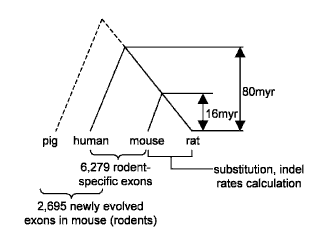 They also note, "The newly evolved exons generally have an accelerated amino acid evolution rate compared with old exons," which suggests to them that "positive Darwinian selection might have been a considerable force in the evolution of these newly evolved exons." Similarly, codons are inserted or deleted about twice as often in the new exons as in older ones. They conclude, "new exons are frequently created in genomes, and... they evolve rapidly at both nucleotide substitution and indel levels."
They also note, "The newly evolved exons generally have an accelerated amino acid evolution rate compared with old exons," which suggests to them that "positive Darwinian selection might have been a considerable force in the evolution of these newly evolved exons." Similarly, codons are inserted or deleted about twice as often in the new exons as in older ones. They conclude, "new exons are frequently created in genomes, and... they evolve rapidly at both nucleotide substitution and indel levels."
We have come to agree that positive darwinian selection would be a logical, efficient way to explore and optimize the given capabilities of newly acquired genetic programs. The phenomenon seems well-observed now, and can be demonstrated in computer models. And, as the molecular biologists observe, "Exon-shuffling has been universally observed in the formation of new genes." This process, analogous to puzzle-solving, is also easily demonstrated in computers.
However, these exons are strands of some 125 to 250 nucletides which were subject to no apparent selective pressure before they were installed. Either from introns or who-knows-where, they emerged already loaded with their essential programmatic content, already compatible with certain other exons, and ready to combine into functioning genes. Computers models do not illuminate this phenomenon. We think the story requires a scientific explanation that darwinism does not provide. But first, one must ask the right question.

 Wen Wang, Hongkun Zheng, Shuang Yang, Haijing Yu et al., "Origin and evolution of new exons in rodents" [abstract], doi:10.1101/gr.3929705, p 1258-1264 v 15, Genome Research, online 18 Aug 2005. Wen Wang, Hongkun Zheng, Shuang Yang, Haijing Yu et al., "Origin and evolution of new exons in rodents" [abstract], doi:10.1101/gr.3929705, p 1258-1264 v 15, Genome Research, online 18 Aug 2005.
 Viruses and Other Gene Transfer Mechanisms is a related CA webpage. [Next-What'sNEW about HGT-Prev] Viruses and Other Gene Transfer Mechanisms is a related CA webpage. [Next-What'sNEW about HGT-Prev]
 Is Sustained Macroevolutionary Progress Possible? is a right question, we think. Is Sustained Macroevolutionary Progress Possible? is a right question, we think.
 How Is It Possible? mentions and gives references (13-17) about accelerated or "adaptive" mutation. How Is It Possible? mentions and gives references (13-17) about accelerated or "adaptive" mutation.

 21 August 2005 21 August 2005
Fred Hoyle is remembered at Cambridge with a two-page profile in the alumni magazine.
 Simon Mitton, "Exploding Star" [pdf], n 45, Cambridge Alumni Magazine, Easter 2005. Simon Mitton, "Exploding Star" [pdf], n 45, Cambridge Alumni Magazine, Easter 2005.
 Fred Hoyle... is a related CA webpage. Fred Hoyle... is a related CA webpage.
 Thanks, Martin Packer. Thanks, Martin Packer.
 6 August 2005
6 August 2005
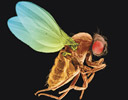 Parallel evolution has been observed in fruitflies. Three different species of drosophila used virtually the same path, independently, to evolve genes with Adh-related functions. In each case, the original Adh gene fused with the 5' end of another gene and underwent an "early burst of adaptive amino acid evolution." In this process, "many of the same amino acids changed in all three" proteins. "This striking similarity of substitution cannot be attributed to chance", the biologists believe. The changes apparently allow the enzymes to act on alcohols different from those targeted by the original alcohol dehydrogenase. Preliminary data point to a fourth example of the phenomenon in another fruitfly species.
Parallel evolution has been observed in fruitflies. Three different species of drosophila used virtually the same path, independently, to evolve genes with Adh-related functions. In each case, the original Adh gene fused with the 5' end of another gene and underwent an "early burst of adaptive amino acid evolution." In this process, "many of the same amino acids changed in all three" proteins. "This striking similarity of substitution cannot be attributed to chance", the biologists believe. The changes apparently allow the enzymes to act on alcohols different from those targeted by the original alcohol dehydrogenase. Preliminary data point to a fourth example of the phenomenon in another fruitfly species. The evolutionary mechanisms in strong panspermia depend on powerful software management systems within eukaryotic genomes. These systems would be capable of assembling and optimizing genetic programs that may be acquired in pieces. The parallel evolution observed here would be hard to explain without such systems, we think.
 Corbin D. Jones and David J. Begun, "Parallel evolution of chimeric fusion genes" [abstract], doi: 10.1073/pnas.0503528102, p 11373-11378 v 102 Proc. Natl. Acad. Sci. USA, 9 Aug (online 2 Aug) 2005. Corbin D. Jones and David J. Begun, "Parallel evolution of chimeric fusion genes" [abstract], doi: 10.1073/pnas.0503528102, p 11373-11378 v 102 Proc. Natl. Acad. Sci. USA, 9 Aug (online 2 Aug) 2005.
 Viruses and Other Gene Transfer Mechanisms is a related CA webpage. [Next-What'sNEW about HGT-Prev] Viruses and Other Gene Transfer Mechanisms is a related CA webpage. [Next-What'sNEW about HGT-Prev]
 The evolution of a new fruitfly gene is a related What'sNEW item, 26 Nov 2004. The evolution of a new fruitfly gene is a related What'sNEW item, 26 Nov 2004.
 5 August 2005
5 August 2005
 Mirror life? NASA scientists Richard Hoover and Elena Pikuta are looking for microbes whose chirality is the opposite of that exhibited by ordinary life. If they find any, its source will necessarily be entirely separate from that of life as we know it. Australian astrobiologist and writer Paul Davies discusses this research in The Sydney Morning Herald.
Mirror life? NASA scientists Richard Hoover and Elena Pikuta are looking for microbes whose chirality is the opposite of that exhibited by ordinary life. If they find any, its source will necessarily be entirely separate from that of life as we know it. Australian astrobiologist and writer Paul Davies discusses this research in The Sydney Morning Herald.
 The search for alien life on Earth, The Sydney Morning Herald, 1 Aug 2005. The search for alien life on Earth, The Sydney Morning Herald, 1 Aug 2005.
 Fossilized Life Forms in the Murchison Meteorite discusses earlier work by Richard Hoover. Fossilized Life Forms in the Murchison Meteorite discusses earlier work by Richard Hoover.

 4 August 2005
4 August 2005
President Bush backs the teaching of Intelligent Design in US high schools. He did not say whether he wanted it taught as science or as something else. One could argue that the standard darwinian theory of evolution must be flawed, if the President of the United States thinks an alternative merits consideration. We wish that he would promote a fully scientific alternative.
 Bush Backs Teaching Intelligent Design, Science Now, 2 Aug 2005. Bush Backs Teaching Intelligent Design, Science Now, 2 Aug 2005.
 Evolution versus Creationism is a related CA webpage. Evolution versus Creationism is a related CA webpage.
 Chip Morrison asks about differences betweeen ID and CA, 2 Aug 2005. Chip Morrison asks about differences betweeen ID and CA, 2 Aug 2005.
 30 July 2005
30 July 2005
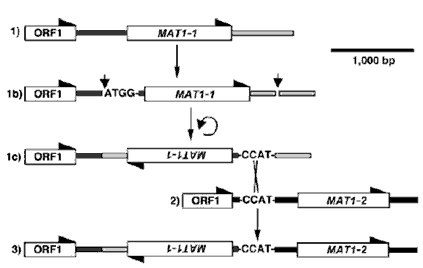 Gene transfer in fungi accounts best for the acquisition of certain genetic programming controlling mating, Canadian and US botanists conclude. Asking how Stemphylia are able to reproduce asexually when their close relatives cannot, the team first identified the specific genes that account for this difference. Then they conducted phylogenetic analyses of the genes. "We had expected that ...self-fertility would have originated in different species by independent mating-type gene fusions. Instead, we found evidence for a single fusion that was transferred across lineages." They even add, "No other evolutionary event could have caused the discontinuous distribution of the fused MAT regions in the Stemphylium species phylogeny."
Gene transfer in fungi accounts best for the acquisition of certain genetic programming controlling mating, Canadian and US botanists conclude. Asking how Stemphylia are able to reproduce asexually when their close relatives cannot, the team first identified the specific genes that account for this difference. Then they conducted phylogenetic analyses of the genes. "We had expected that ...self-fertility would have originated in different species by independent mating-type gene fusions. Instead, we found evidence for a single fusion that was transferred across lineages." They even add, "No other evolutionary event could have caused the discontinuous distribution of the fused MAT regions in the Stemphylium species phylogeny."
Lateral transfer and rearrangement of genes or substantial portions of them, as implicated here, are components of a newly appreciated way for eukaryotes to acquire genetic programs. It is different from the standard darwinian mechanism of gradual mutation. For bacterial evolution the paradigm shift toward lateral gene transfer is already well advanced. Now, evolutionary examples like this one are becoming noticed among eukaryotes as well.
 Patrik Inderbitzin et al., "Lateral transfer of mating system in Stemphylium" [abstract], p 11390-11395 v 102, Proc. Nat. Acad. Sci. USA, 9 Aug 2005. Patrik Inderbitzin et al., "Lateral transfer of mating system in Stemphylium" [abstract], p 11390-11395 v 102, Proc. Nat. Acad. Sci. USA, 9 Aug 2005.
 Viruses and Other Gene Transfer Mechanisms is a related CA webpage listing many examples of gene transfer in all of life's domains. [Next-What'sNEW about HGT-Prev] Viruses and Other Gene Transfer Mechanisms is a related CA webpage listing many examples of gene transfer in all of life's domains. [Next-What'sNEW about HGT-Prev]
 28 July 2005
28 July 2005

Spitzer in orbit (illustration) |
Cosmic organics — "NASA's Spitzer Space Telescope has found the ingredients for life all the way back to a time when the universe was a mere youngster," says the Spitzer Science Center. The orbiting infrared telescope saw the spectroscopic signature of organic compounds called polycyclic aromatic hydrocarbons ("PAHs") in galaxies so distant that we are seeing them as they were over 10 billion years ago. "These complex molecules are very common on Earth. They form any time carbon-based materials are not burned completely. They can be found in sooty exhaust from cars and airplanes, and in charcoal broiled hamburgers and burnt toast," the press release continues. (We note that all of these earthly examples are not pre-, but post-biological.)The Spitzer Space Telescope was launched 25 August 2003 into an Earth-trailing solar orbit. Its 85 cm diameter mirror is cooled to less 5.5 K, to obtain images and spectra at wavelengths of 3 and 180 microns.
 Spitzer Finds Life Components in Young Universe, Spitzer Science Center, 28 Jul 2005. Spitzer Finds Life Components in Young Universe, Spitzer Science Center, 28 Jul 2005.
 ...Interstellar Dust is a related CA webpage. ...Interstellar Dust is a related CA webpage.
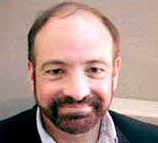
 21 July 2005
21 July 2005
Rocco Mancinelli, a Principal Investigator for SETI, studies Earth's extremophiles for capabilities that might help similar organisms survive in space. He concludes that radiation poses the greatest threat, but not always a fatal one. "Therefore, life, as we know it could travel between other bodies within the solar system and the Earth, and indeed the life we find on Earth may have been, or may be, present elsewhere."
 Seeking Deep Space Salt Lovers, by Rocco Mancinelli, Space.com, 21 Jul 2005. Seeking Deep Space Salt Lovers, by Rocco Mancinelli, Space.com, 21 Jul 2005.
 Bacteria... is a related CA webpage. Bacteria... is a related CA webpage.
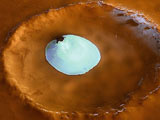
 20 July 2005
20 July 2005
Frozen water on Mars may be 200 meters thick on the floor of a 35-kilometer wide crater in Mars' northern hemisphere. The Mars Express spacecraft took this photo of it in February.
 Water Ice in a Martian Crater, Astronomy Picture of the Day, 20 Jul 2005. Water Ice in a Martian Crater, Astronomy Picture of the Day, 20 Jul 2005.
More about Mars' methane from NASA: did life produce it?
 Methane on Mars, part 1, by David Tenenbaum, Astrobiology Magazine, 20 Jul 2005. Part 2 | 3 | 4. Methane on Mars, part 1, by David Tenenbaum, Astrobiology Magazine, 20 Jul 2005. Part 2 | 3 | 4.
 Life on Mars! is a related CA webpage. Life on Mars! is a related CA webpage.
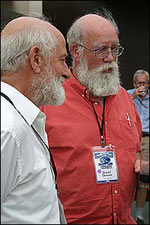
Peter Grant (left) and Daniel Dennett – photo by Michael Shermer |
 14 July 2005 14 July 2005
The World Summit on Evolution in the Galapagos Islands, 8-12 June, was attended by 210 scientists, students and journalists. "It was a veritable Who's Who of evolutionary theory, including William Calvin, Daniel Dennett, Niles Eldredge, Douglas Futuyma, Peter and Rosemary Grant, Antonio Lazcano, Lynn Margulis, William Provine, William Schopf, Frank Sulloway, Timothy White and others," writes Michael Shermer in Scientific American. The conference addressed many of the live issues within darwinism, including the definition of species, the target of selection (from genes to cells and individuals to species and communities), and just when Darwin became a darwinist. Lynn Margulis even distinguished between darwinism (good) and neo-darwinism (bad). But Shermer considers these disagreements healthy and he concludes, "the theory of evolution has never been stronger."
In his own lecture in the Galapagos he had bolstered this conclusion by deconstructing at length the tenets of creationism or Intelligent Design. Apparently, no other criticism of darwinism was even addressed at the conference, although Shermer's article once mentions "other outsiders."
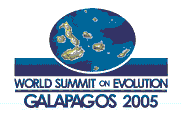 Shermer explains, "Creationists and Intelligent Design theorists like to inquire how information can increase in a world filled with entropy and the decay of information. Symbiogenesis is one answer--incorporating the genome of other organisms." If there are other answers, he doesn't list them. Of course, symbiogenesis is a form of gene transfer — a wholesale one to be sure. Gene transfer adds information to the acquiring species, but not to the world. Shermer appears to have reasoned hastily and badly here. As Founding Publisher of Skeptic magazine and the Director of the Skeptics Society, he could do better.
Shermer explains, "Creationists and Intelligent Design theorists like to inquire how information can increase in a world filled with entropy and the decay of information. Symbiogenesis is one answer--incorporating the genome of other organisms." If there are other answers, he doesn't list them. Of course, symbiogenesis is a form of gene transfer — a wholesale one to be sure. Gene transfer adds information to the acquiring species, but not to the world. Shermer appears to have reasoned hastily and badly here. As Founding Publisher of Skeptic magazine and the Director of the Skeptics Society, he could do better.
We ask related questions: Can new genetic programs be acquired without gene transfer? Is evolutionary progress in a closed system possible? We wish darwinists like Shermer would carefully consider these questions and the evidence related to them.  The Woodstock of Evolution, by Michael Shermer, ScientificAmerican.com, 27 Jun 2005. The Woodstock of Evolution, by Michael Shermer, ScientificAmerican.com, 27 Jun 2005.
 Conference announcement from The Universidad San Francisco de Quito (USFQ). Conference announcement from The Universidad San Francisco de Quito (USFQ).
 Successful Inauguration of the World Summit on Evolution 2005, Newswise.com, 10 Jun 2005. Successful Inauguration of the World Summit on Evolution 2005, Newswise.com, 10 Jun 2005.
 Neo-Darwinism... is a related CA webpage. Neo-Darwinism... is a related CA webpage.
 Dr. Michael Shermer would prefer not to discuss this science issue, 18-24 Jul 2005. Dr. Michael Shermer would prefer not to discuss this science issue, 18-24 Jul 2005.
 Thanks, Kevin Hatfield. Thanks, Kevin Hatfield.

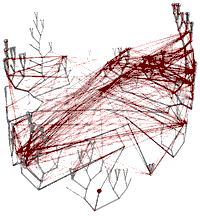 1 July 2005
1 July 2005
A new microbial tree of life has been drawn by geneticists at the European Molecular Biology Laboratory. The importance of horizontal transfer (colored lines) is clear in it. "A gene can rapidly be disseminated from organism to organism through very few horizontal gene transfer events," they comment. Also, "...Hubs can serve as bacterial 'gene banks,' providing a medium to acquire and redistribute genes in the microbial communities...."
 Trees, vines and nets: Microbial evolution changes its face, European Molecular Biology Laboratory, 1 Jul 2005. Trees, vines and nets: Microbial evolution changes its face, European Molecular Biology Laboratory, 1 Jul 2005.
 Victor Kunin et al., "The net of life: Reconstructing the microbial phylogenetic network" [abstract], p 954-959 v 15, Genome Research, Jul (online 17 Jun) 2005. Victor Kunin et al., "The net of life: Reconstructing the microbial phylogenetic network" [abstract], p 954-959 v 15, Genome Research, Jul (online 17 Jun) 2005.
 Viruses and Other Gene Transfer Mechanisms is a related CA webpage. [Next-What'sNEW about HGT-Prev] Viruses and Other Gene Transfer Mechanisms is a related CA webpage. [Next-What'sNEW about HGT-Prev]
 The Tree of Life is a related CA webpage. The Tree of Life is a related CA webpage.
 Thanks, Jerry? Thanks, Jerry?
|
 The chimp genome has been sequenced. What it may reveal about evolution since the chimp-human split interests everyone, incuding us. We recognize that studying evolution by comparing today's genomes requires inference, and the method leaves many questions unanswered. Nonetheless, some basic findings seem sure (and we are warming up to the method):
The chimp genome has been sequenced. What it may reveal about evolution since the chimp-human split interests everyone, incuding us. We recognize that studying evolution by comparing today's genomes requires inference, and the method leaves many questions unanswered. Nonetheless, some basic findings seem sure (and we are warming up to the method):
 Today's protein families have been fine-tuned from ancient templates. This conclusion emerged unexpectedly from research into the rules that govern protein folding at Southwestern Medical Center in Dallas. Investigators there used statistical coupling analysis (SCA) to analyze a large family of small protein modules called the WW domains. (These domains, 37 amino acids in length, bind to certain proline-rich target sequences.) The research team compared 42 randomly chosen, naturally occurring variants of the WW domain with equally many artificial ones created by each of two algorithms. One of the algorithms substituted residues according to the "mutually evolving network" rules observed in nature; the other one didn't. Only the former algorithm produced sequences that would fold into functional protein modules. While this result interested the researchers, they add, "More surprising is the finding of sparseness." They elaborated —
Today's protein families have been fine-tuned from ancient templates. This conclusion emerged unexpectedly from research into the rules that govern protein folding at Southwestern Medical Center in Dallas. Investigators there used statistical coupling analysis (SCA) to analyze a large family of small protein modules called the WW domains. (These domains, 37 amino acids in length, bind to certain proline-rich target sequences.) The research team compared 42 randomly chosen, naturally occurring variants of the WW domain with equally many artificial ones created by each of two algorithms. One of the algorithms substituted residues according to the "mutually evolving network" rules observed in nature; the other one didn't. Only the former algorithm produced sequences that would fold into functional protein modules. While this result interested the researchers, they add, "More surprising is the finding of sparseness." They elaborated —
 Deep inside comet Tempel 1 there are lots of organic compounds, planetary scientist Michael A'Hearn announced today. A 370-kilogram projectile from NASA's Deep Impact mission collided with the comet and penetrated a layer of fine icy dust at least 30 feet deep on July 4th. While the data are still being analysed, organics in the interior of a comet are confirmed for the first time. Experts are noting that these could have played a major role in the origin of life on Earth. We welcome this small paradigm shift.
Deep inside comet Tempel 1 there are lots of organic compounds, planetary scientist Michael A'Hearn announced today. A 370-kilogram projectile from NASA's Deep Impact mission collided with the comet and penetrated a layer of fine icy dust at least 30 feet deep on July 4th. While the data are still being analysed, organics in the interior of a comet are confirmed for the first time. Experts are noting that these could have played a major role in the origin of life on Earth. We welcome this small paradigm shift.


 They also note, "The newly evolved exons generally have an accelerated amino acid evolution rate compared with old exons," which suggests to them that "positive Darwinian selection might have been a considerable force in the evolution of these newly evolved exons." Similarly, codons are inserted or deleted about twice as often in the new exons as in older ones. They conclude, "new exons are frequently created in genomes, and... they evolve rapidly at both nucleotide substitution and indel levels."
They also note, "The newly evolved exons generally have an accelerated amino acid evolution rate compared with old exons," which suggests to them that "positive Darwinian selection might have been a considerable force in the evolution of these newly evolved exons." Similarly, codons are inserted or deleted about twice as often in the new exons as in older ones. They conclude, "new exons are frequently created in genomes, and... they evolve rapidly at both nucleotide substitution and indel levels."

 Parallel evolution has been observed in fruitflies. Three different species of drosophila used virtually the same path, independently, to evolve genes with Adh-related functions. In each case, the original Adh gene fused with the 5' end of another gene and underwent an "early burst of adaptive amino acid evolution." In this process, "many of the same amino acids changed in all three" proteins. "This striking similarity of substitution cannot be attributed to chance", the biologists believe. The changes apparently allow the enzymes to act on alcohols different from those targeted by the original alcohol dehydrogenase. Preliminary data point to a fourth example of the phenomenon in another fruitfly species.
Parallel evolution has been observed in fruitflies. Three different species of drosophila used virtually the same path, independently, to evolve genes with Adh-related functions. In each case, the original Adh gene fused with the 5' end of another gene and underwent an "early burst of adaptive amino acid evolution." In this process, "many of the same amino acids changed in all three" proteins. "This striking similarity of substitution cannot be attributed to chance", the biologists believe. The changes apparently allow the enzymes to act on alcohols different from those targeted by the original alcohol dehydrogenase. Preliminary data point to a fourth example of the phenomenon in another fruitfly species. Mirror life? NASA scientists Richard Hoover and Elena Pikuta are looking for microbes whose chirality is the opposite of that exhibited by ordinary life. If they find any, its source will necessarily be entirely separate from that of life as we know it. Australian astrobiologist and writer Paul Davies discusses this research in The Sydney Morning Herald.
Mirror life? NASA scientists Richard Hoover and Elena Pikuta are looking for microbes whose chirality is the opposite of that exhibited by ordinary life. If they find any, its source will necessarily be entirely separate from that of life as we know it. Australian astrobiologist and writer Paul Davies discusses this research in The Sydney Morning Herald.
 Gene transfer in fungi accounts best for the acquisition of certain genetic programming controlling mating, Canadian and US botanists conclude. Asking how Stemphylia are able to reproduce asexually when their close relatives cannot, the team first identified the specific genes that account for this difference. Then they conducted phylogenetic analyses of the genes. "We had expected that ...self-fertility would have originated in different species by independent mating-type gene fusions. Instead, we found evidence for a single fusion that was transferred across lineages." They even add, "No other evolutionary event could have caused the discontinuous distribution of the fused MAT regions in the Stemphylium species phylogeny."
Gene transfer in fungi accounts best for the acquisition of certain genetic programming controlling mating, Canadian and US botanists conclude. Asking how Stemphylia are able to reproduce asexually when their close relatives cannot, the team first identified the specific genes that account for this difference. Then they conducted phylogenetic analyses of the genes. "We had expected that ...self-fertility would have originated in different species by independent mating-type gene fusions. Instead, we found evidence for a single fusion that was transferred across lineages." They even add, "No other evolutionary event could have caused the discontinuous distribution of the fused MAT regions in the Stemphylium species phylogeny."




 Shermer explains, "Creationists and Intelligent Design theorists like to inquire how information can increase in a world filled with entropy and the decay of information. Symbiogenesis is one answer--incorporating the genome of other organisms." If there are other answers, he doesn't list them. Of course, symbiogenesis is a form of gene transfer — a wholesale one to be sure. Gene transfer adds information to the acquiring species, but not to the world. Shermer appears to have reasoned hastily and badly here. As Founding Publisher of Skeptic magazine and the Director of the Skeptics Society, he could do better.
Shermer explains, "Creationists and Intelligent Design theorists like to inquire how information can increase in a world filled with entropy and the decay of information. Symbiogenesis is one answer--incorporating the genome of other organisms." If there are other answers, he doesn't list them. Of course, symbiogenesis is a form of gene transfer — a wholesale one to be sure. Gene transfer adds information to the acquiring species, but not to the world. Shermer appears to have reasoned hastily and badly here. As Founding Publisher of Skeptic magazine and the Director of the Skeptics Society, he could do better.
 1 July 2005
1 July 2005